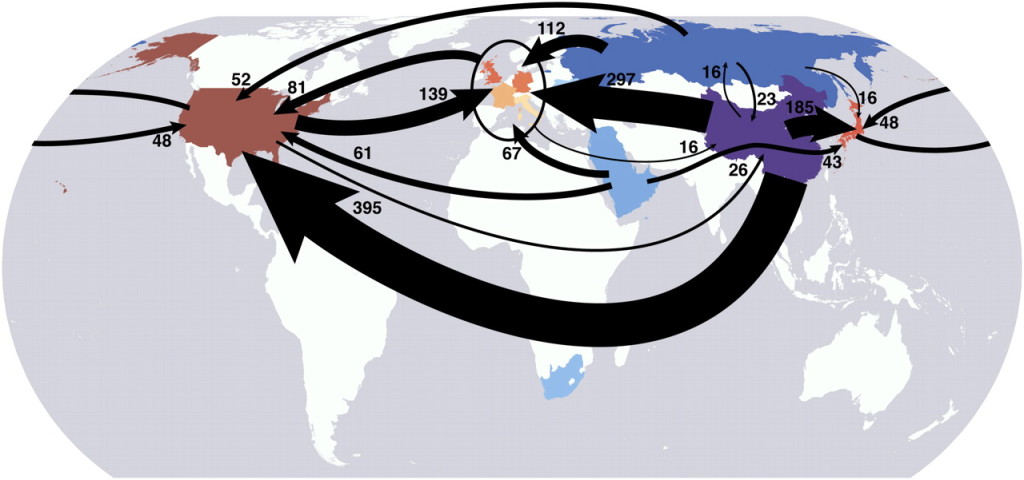Passing Gas
A better accounting of GHGs can improve the climate discourse
The tendency to divide global GHG emissions by country is a product of the well-mixed dispersal of most of warming gases, and the international politics that attach to cross-border pollution. A country’s emission numbers imply accountability and culpability, and frame the discourse on how to respond. Going forward on policymaking, it’s worth looking at how these emissions are calculated, and whether the numbers cited accurately reflect international accountability for climate change.

First, a quick look at how the national emissions figures matter. According to the latest U.N. Environmental Program Gap Report, “developing” countries accounted for about 60 percent of global GHG emissions in 2010, outpacing the traditionally GHG-prolific “developed” countries. Another recent study finds that by 2020, developing countries will have contributed 51 percent of all the GHGs that humans have ever emitted, effectively making the developing world the primary cause of future global climate impacts. These figures underlie the position of developing countries at the climate talks that wound up in Warsaw on Friday. Relative to developing nations, the developed world was pushing for an egalitarian, forward-facing division of climate response burden, in line with the recent accountability figures. Developing countries, meanwhile, point to the disparities in both wealth and historic greenhouse gas contributions, to push for stricter requirements on the developed countries, including compensation for the climate harms now occurring or predicted as a result of the richer countries’ development. The underlying theme of accountability in these debates is shaped largely by the national emissions data.
The national figures, with few exceptions, are obtained through a “production-based accounting”; that is, they attribute the emissions to the country where the emissions enter the atmosphere. This approach makes sense; it’s just the way you’d expect emissions to be measured. To the question “where are the emissions coming from?” you look at sources, like cars and factories and power plants, and you trace the border lines.
But this may not be the best approach. The problem is that, under a production-based accounting, developed countries can essentially “outsource” a percentage of their emissions in a way that transfers some of their accountability for climate impacts. Two trends of the last few decades bear this out. The first is the boom in the emissions of developing countries. The second is a boom in global trade, which is responsible for some of those developing country emissions. Among other results, increased international trade has transformed developing countries from full-service economies into planners and purchasers increasingly reliant on the manufacturing and industrial sectors of the developing world. This has meant that much of the GHG-intensive industry that was previously housed in countries like the U.S. has moved to poorer countries, who sell back much of the resulting products. In essence, developing countries get to pass off the GHGs, but keep the other outputs. This is a sort of leakage, like the kind that arises in the cap and trade context, except that it doesn’t follow any specific regulation that might plan for it.

At best, this is a problem for fair and accurate accounting, something that could skew perception and policy. At worst, it’s a case of first-world “blame it on the doggy,” which casts developing countries in an unflattering and undeserved role (-“Ew, who let out that greenhouse gas?” -“I think India did it.”). Because many GHGs follow industry, a developing country can improve its GHG numbers by moving its industry outside its borders.
There’s another way to count emissions, though, which factors this outsourcing. This is “consumption-based accounting”; it calculates a country’s emissions according to what it uses, rather than what it produces. Under a consumption-based accounting, if a Chinese factory manufactures 10,000 miniature American flags, which are then sold in the U.S., the U.S. gets the bill for the GHG emissions involved in producing the flags, rather than China. The conception of a country’s GHG emissions as a selfish act against the rest of the world can break down when you see where some of the emissions are actually going, and a consumption-based accounting reflects the difference.
Measuring by consumption addresses the fairness issues of outsourced GHGs, but it has yet to catch on in most contexts. There’s a body of scholarly research on the topic, including Consumption-based accounting of CO2 emissions, a 2010 study from two Stanford scientists. This study compares production- and consumption-based models of 2004 CO2 emissions. It shows a few startling discrepancies. Of note, about 28 percent of China’s 2004 emissions were embodied in exports, leaving China with a net consumption-based accounting of CO2 that is about 77 percent of its (conventionally reported) production-based emissions. On the other side of the scales, a consumption-based accounting of 2004 U.S. CO2 adds about 12 percent to its production-based totals. The differences may be even more pronounced for lesser emitters. For example, consumption-based accounting adds about 45 percent to the U.K.’s 2004 production-based CO2 emissions.
The difference has fallen a bit in recent years, as the global recession has cooled trade, but it’s still a factor, and will probably grow as trade increases. The figure below, from a 2013 report by the Organisation for Economic Co-operation and Development (OECD), compares Chinese and American CO2 emissions under both accounting methods for 2009, at the low point of recent trade volume. That year, there was still a marked difference in the countries’ relative emissions—2009 emissions in China and the U.S. were almost equal, even though production-based accounting famously showed that China passed the U.S. as the largest GHG emitter in 2006.

Consumption-based accounting requires a much closer look than production-based models. But it may be worth the effort. The emissions embodied in trade are non-negligible, and could constructively affect the international discourse, and the internal policymaking decisions of each country. It’s probably unrealistic to rely on source countries to assume primary responsibility for the emissions that are outsourced to them, and a discussion based on consumption-based responsibility could yield more effective action from those that are best able to respond.
Reader Comments
One Reply to “Passing Gas”
Comments are closed.








I understand the appeal of using consumption based accounting. On the other hand, if those emissions count against the U.S., presumably we should have the right to reduce them — for example, by putting a carbon tax on imports from China or by demanding that China switch away from coal. Or we could just stop buying from China entirely. I think the Chinese would object to that, but it seems harsh to say that we’re accountable for emissions that we can’t control.